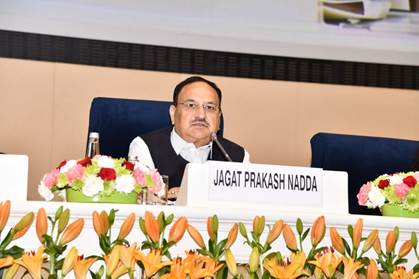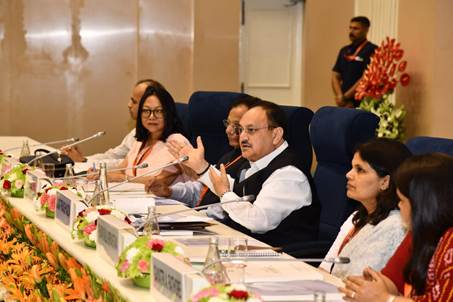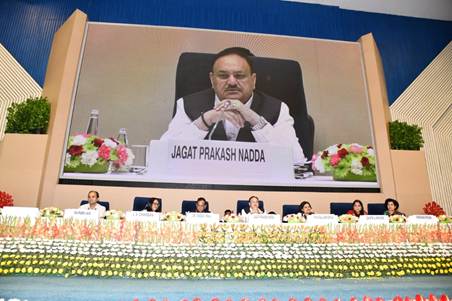Ministry of Health and Family Welfare
Union Health Minister Shri JP Nadda chairs breakaway session, “Promoting Swasth Bharat through Ayushman Bharat PM Jan Arogya Yojana and Ayushman Arogya Mandir” during Civil Services Day Celebrations in New Delhi
Two pillars of Ayushman Bharat – AAM and AB PMJAY are a result of a very well-thought process which started in 2015 and culminated with the adoption of the National Health Policy in 2017: Shri JP Nadda
“National Health Policy 2017 is the first such policy covering all aspects of healthcare holistically”
Highlights need for enhancing capacity of health administrators to ensure timely and effective decision making, enhancing capacity of ASHA and community health workers, strengthening hub-and-spoke model of digital health intervention and monitoring and assessment of health impacts
Ayushman Bharat encompass the philosophy of Universal Health Care and also builds the pathway to achieve UHC: Dr VK Paul
“Thanks to AB PMJAY, hospitalization rates in India has increased by 40% and out-of-pocket expenditure has decreased from 64% in 2013-14 to 39.4% in 2021-22”
प्रविष्टि तिथि:
21 APR 2025 6:42PM by PIB Delhi
Union Health and Family Welfare Minister Shri Jagat Prakash Nadda chaired a breakaway session titled “Promoting Swasth Bharat through Ayushman Bharat PM Jan Arogya Yojana and Ayushman Arogya Mandir” during the Cvil Services Day celebrations, here today. Dr V K Paul, Member (Health), NITI Aayog was also present.

Addressing the gathering, Shri JP Nadda stated that providing affordable and quality healthcare to every poor person in the country is a priority of the central government and the two pillars of Ayushman Bharat initiative – Ayushman Arogya Mandir and AB PMJAY (Pradhan Mantri Jan Arogya Yojana) are a result of a very well-thought process. “The consultations started in 2015, zonal conferences were held in 2016 and in 2016, the National Health Policy was laid out which is first such policy covering all aspects of healthcare holistically”, he stated.
Shri Nadda highlighted that the government’s expenditure on healthcare has increased from 29% in 2014 to 48% today leading to decline in out-of-pocket expenditure of people. He stated that screening of communicable and non-communicable diseases in Ayushman Arogya Mandir and expanding the package of services being provided there has helped in providing preventive and promotive healthcare and addressing the growing concern of lifestyle diseases. “Health facilities are being encouraged to undertake self-assessment under the Indian Public Health Standards 2022 and National Quality Assurance Standards (NQAS)”, he stated.

The Union Health Minister also highlighted the need for enhancing capacity of health administrators to ensure timely and effective decision making, working on the program implementation plans, enhancing the capacity of ASHA workers and community health workers, strengthening and institutionalizing the hub-and-spoke model of digital health intervention and monitoring and assessment of health impacts.
Union Health Minister stated that the narrative that there is less funding for the health sector will soon end. He stated that while the Central Govt is providing it’s share of funding, there is lack of absorption in the states.
Shri Nadda urged the young officers to have an impact survey done of the benefits that have accrued from the programmes of the Health Ministry at the ground level.
He concluded his address by stating that while there has been a tremendous progress in healthcare in the last 10 years, the government is committed towards providing affordable, accessible, equitable and quality healthcare for all.
Speaking on the occasion, Dr V K Paul stated that the underlying motivation behind today’s paradigm for health is achieving the goal of Universal Health Coverage (UHC), i.e., to ensure that every citizen has access to quality healthcare without financial hardship. He stated that health coverage today not only entails curative treatment but also promotive, preventive, palliative, rehabilitative and therapeutic. “The two pillars of Ayushman Bharat initiative – Ayushman Arogya Mandir and AB PMJAY encompass the philosophy of UHC and also builds the pathway to achieve UHC.”
Dr Paul stated that “as many as 90% of essential interventions for UHC can be delivered through primary healthcare systems” and “an estimated 75% of projected health gains under the SDGs can be achieved through primary healthcare system”. He highlighted that countries with strong primary healthcare have higher life expectancy, better health outcomes, lower medication use and overall lower medical costs. “Because of this, the National Health Policy attaches prime importance to this and commits two-third of financial resources to primary healthcare system.”
Dr Paul highlighted that thanks to AB PMJAY, hospitalization rates in India has increased by 40%. “The out-of-pocket expenditure has decreased from 64% in 2013-14 to 39.4% in 2021-22”, he stated. He stated that these figures highlight that the two pillars of Ayushman Bharat are serving their purpose. He concluded his address by urging the different ministries and departments of the Union Government to work in coordination for achieving health goals.

Smt. Punya Salila Srivastava said that India’s dream of Viksit Bharat cannot be attained without achieving ‘Swasthya Bharat’. She stated that healthcare sector has seen a significant uplift in the last decade with the launch of initiatives like Ayushman Bharat. She stated, “Ayushman Bharat is based on providing continuum of care from providing comprehensive primary healthcare through Ayushman Arogya Mandir with referral and research linkages for follow-up to secondary and tertiary healthcare. AB PMJAY falls under the second pillar. To enable the referral linkages, there is the Ayushman Bharat Digital Mission (ABDM) which falls under the third pillar and the PM ABHIM (Pradhan Mantri Ayushman Bharat Health Infrastructure Mission) comes under the last pillar to address infrastructure gaps.”
The Union Health Secretary gave an overview of the health system strengthening approach under the National Health Mission which operates under three broad pillars: Reproductive, Maternal, Newborn, Child, Adolescent Health and Nutrition; Communicable Diseases and Non-Communicable Diseases.
She highlighted India’s success in decline of Maternal Mortality Ratio (MMR) which is more than double that of the global decline. “Similarly, India’s decline in Infant Mortality Rate (IMR) and Under 5 Mortality Rate (U5MR) is also much higher than the global decline”, she stated. She also highlighted that 31 states have achieved replacement level of fertility as per NFHS-5. Smt. Srivastava informed that these successes are the result of developing very comprehensive primary healthcare system by strengthening our primary healthcare centres and sub-centres and developing them as Ayushman Arogya Mandirs.

Smt. Gayatri A. Rathore, Principal Secretary of Medical & Health and Family Welfare, Govt. of Rajasthan; Smt. L S Changsan, Addl. Secretary, Union Health Ministry; Smt. Aradhana Patnaik, Addl. Secretary and Mission Director (NHM), Union Health Ministry; Shri Saurabh Jain, Joint Secretary, Union Health Ministry and senior officers of the Union Government were present on the occasion.
*****
MV
HFW/HFM Civil Services Day Address/21 April 2025/2
(रिलीज़ आईडी: 2123250)
आगंतुक पटल : 1133